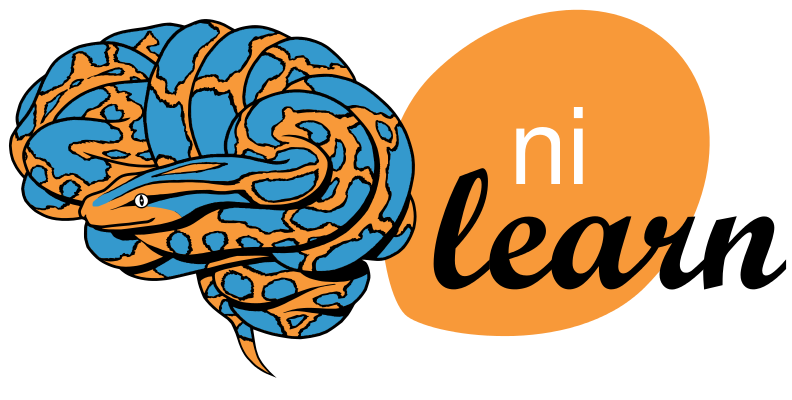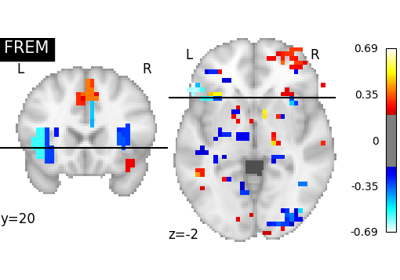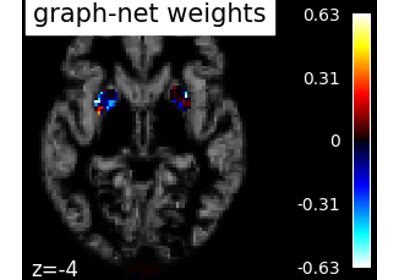Note
This page is a reference documentation. It only explains the class signature, and not how to use it. Please refer to the user guide for the big picture.
8.3.6. nilearn.decoding.SpaceNetRegressor¶
- class
nilearn.decoding.SpaceNetRegressor(penalty='graph-net', l1_ratios=0.5, alphas=None, n_alphas=10, mask=None, target_affine=None, target_shape=None, low_pass=None, high_pass=None, t_r=None, max_iter=200, tol=0.0001, memory=Memory(location=None), memory_level=1, standardize=True, verbose=1, n_jobs=1, eps=0.001, cv=8, fit_intercept=True, screening_percentile=20.0, debias=False)¶ Regression learners with sparsity and spatial priors.
SpaceNetRegressor implements Graph-Net and TV-L1 priors / penalties for regression problems. Thus, the penalty is a sum an L1 term and a spatial term. The aim of such a hybrid prior is to obtain weights maps which are structured (due to the spatial prior) and sparse (enforced by L1 norm).
- Parameters
- penaltystring, optional (default ‘graph-net’)
Penalty to used in the model. Can be ‘graph-net’ or ‘tv-l1’.
- l1_ratiosfloat or list of floats in the interval [0, 1]; optional (default .5)
Constant that mixes L1 and spatial prior terms in penalization. l1_ratio == 1 corresponds to pure LASSO. The larger the value of this parameter, the sparser the estimated weights map. If list is provided, then the best value will be selected by cross-validation.
- alphasfloat or list of floats, optional (default None)
Choices for the constant that scales the overall regularization term. This parameter is mutually exclusive with the n_alphas parameter. If None or list of floats is provided, then the best value will be selected by cross-validation.
- n_alphasint, optional (default 10).
Generate this number of alphas per regularization path. This parameter is mutually exclusive with the alphas parameter.
- epsfloat, optional (default 1e-3)
Length of the path. For example,
eps=1e-3means thatalpha_min / alpha_max = 1e-3- maskfilename, niimg, NiftiMasker instance, optional (default None)
Mask to be used on data. If an instance of masker is passed, then its mask will be used. If no mask is it will be computed automatically by a MultiNiftiMasker with default parameters.
- target_affine3x3 or 4x4 matrix, optional (default None)
This parameter is passed to image.resample_img. Please see the related documentation for details.
- target_shape3-tuple of integers, optional (default None)
This parameter is passed to image.resample_img. Please see the related documentation for details.
- low_pass: None or float, optional
This parameter is passed to signal.clean. Please see the related documentation for details
- high_pass: None or float, optional
This parameter is passed to signal.clean. Please see the related documentation for details
- t_rfloat, optional (default None)
This parameter is passed to signal.clean. Please see the related documentation for details
- screening_percentilefloat in the interval [0, 100]; Optional (default 20)
Percentile value for ANOVA univariate feature selection. A value of 100 means ‘keep all features’. This percentile is is expressed w.r.t the volume of a standard (MNI152) brain, and so is corrected at runtime to correspond to the volume of the user-supplied mask (which is typically smaller).
- standardizebool, optional (default True):
If set, then we’ll center the data (X, y) have mean zero along axis 0. This is here because nearly all linear models will want their data to be centered.
- fit_interceptbool, optional (default True)
Fit or not an intercept.
- max_iterint (default 200)
Defines the iterations for the solver.
- tolfloat
Defines the tolerance for convergence. Defaults to 1e-4.
- verboseint, optional (default 1)
Verbosity level.
- n_jobsint, optional (default 1)
Number of jobs in solving the sub-problems.
- memory: instance of joblib.Memory or string
Used to cache the masking process. By default, no caching is done. If a string is given, it is the path to the caching directory.
- memory_level: integer, optional (default 1)
Rough estimator of the amount of memory used by caching. Higher value means more memory for caching.
- cvint, a cv generator instance, or None (default 8)
The input specifying which cross-validation generator to use. It can be an integer, in which case it is the number of folds in a KFold, None, in which case 3 fold is used, or another object, that will then be used as a cv generator.
- debias: bool, optional (default False)
If set, then the estimated weights maps will be debiased.
- Attributes
- `all_coef_`ndarray, shape (n_l1_ratios, n_folds, n_features)
Coefficients for all folds and features.
- `alpha_grids_`ndarray, shape (n_folds, n_alphas)
Alpha values considered for selection of the best ones (saved in best_model_params_)
- `best_model_params_`ndarray, shape (n_folds, n_parameter)
Best model parameters (alpha, l1_ratio) saved for the different cross-validation folds.
- `coef_`ndarray, shape (n_features,)
Coefficient of the features in the decision function.
- `coef_img_`nifti image
Masked model coefficients
- `mask_`ndarray 3D
An array contains values of the mask image.
- `masker_`instance of NiftiMasker
The nifti masker used to mask the data.
- `mask_img_`Nifti like image
The mask of the data. If no mask was supplied by the user, this attribute is the mask image computed automatically from the data X.
- `memory_`joblib memory cache
- `intercept_`narray, shape (1)
Intercept (a.k.a. bias) added to the decision function. It is available only when parameter intercept is set to True.
- `cv_`list of pairs of lists
Each pair is the list of indices for the train and test samples for the corresponding fold.
- `cv_scores_`ndarray, shape (n_folds, n_alphas) or (n_l1_ratios, n_folds, n_alphas)
Scores (misclassification) for each alpha, and on each fold
- `screening_percentile_`float
Screening percentile corrected according to volume of mask, relative to the volume of standard brain.
- `w_`ndarray, shape (n_features,)
Model weights
- `ymean_`array, shape (n_samples,)
Mean of prediction targets
- `Xmean_`array, shape (n_features,)
Mean of X across samples
- `Xstd_`array, shape (n_features,)
Standard deviation of X across samples
__init__(penalty='graph-net', l1_ratios=0.5, alphas=None, n_alphas=10, mask=None, target_affine=None, target_shape=None, low_pass=None, high_pass=None, t_r=None, max_iter=200, tol=0.0001, memory=Memory(location=None), memory_level=1, standardize=True, verbose=1, n_jobs=1, eps=0.001, cv=8, fit_intercept=True, screening_percentile=20.0, debias=False)¶Initialize self. See help(type(self)) for accurate signature.
SUPPORTED_LOSSES= ['mse', 'logistic']¶
SUPPORTED_PENALTIES= ['graph-net', 'tv-l1']¶
check_params()¶Makes sure parameters are sane
decision_function(X)¶Predict confidence scores for samples
The confidence score for a sample is the signed distance of that sample to the hyperplane.
- Parameters
- X{array-like, sparse matrix}, shape = (n_samples, n_features)
Samples.
- Returns
- array, shape=(n_samples,) if n_classes == 2 else (n_samples, n_classes)
Confidence scores per (sample, class) combination. In the binary case, confidence score for self.classes_[1] where >0 means this class would be predicted.
fit(X, y)¶Fit the learner
- Parameters
- Xlist of Niimg-like objects
See http://nilearn.github.io/manipulating_images/input_output.html Data on which model is to be fitted. If this is a list, the affine is considered the same for all.
- yarray or list of length n_samples
The dependent variable (age, sex, QI, etc.).
Notes
- selfSpaceNet object
Model selection is via cross-validation with bagging.
get_params(deep=True)¶Get parameters for this estimator.
- Parameters
- deepbool, default=True
If True, will return the parameters for this estimator and contained subobjects that are estimators.
- Returns
- paramsdict
Parameter names mapped to their values.
predict(X)¶Predict class labels for samples in X.
- Parameters
- Xlist of Niimg-like objects
See http://nilearn.github.io/manipulating_images/input_output.html Data on prediction is to be made. If this is a list, the affine is considered the same for all.
- Returns
- y_predndarray, shape (n_samples,)
Predicted class label per sample.
score(X, y, sample_weight=None)¶Return the coefficient of determination
 of the prediction.
of the prediction.The coefficient
 is defined as
is defined as  , where
, where  is the residual sum of squares
is the residual sum of squares ((y_true - y_pred) ** 2).sum()and is the total sum of squares
is the total sum of squares ((y_true - y_true.mean()) ** 2).sum(). The best possible score is 1.0 and it can be negative (because the model can be arbitrarily worse). A constant model that always predicts the expected value of y, disregarding the input features, would get a score of 0.0.
score of 0.0.- Parameters
- Xarray-like of shape (n_samples, n_features)
Test samples. For some estimators this may be a precomputed kernel matrix or a list of generic objects instead with shape
(n_samples, n_samples_fitted), wheren_samples_fittedis the number of samples used in the fitting for the estimator.- yarray-like of shape (n_samples,) or (n_samples, n_outputs)
True values for X.
- sample_weightarray-like of shape (n_samples,), default=None
Sample weights.
- Returns
- scorefloat
 of
of self.predict(X)wrt. y.
Notes
The
 score used when calling
score used when calling scoreon a regressor usesmultioutput='uniform_average'from version 0.23 to keep consistent with default value ofr2_score. This influences thescoremethod of all the multioutput regressors (except forMultiOutputRegressor).
set_params(**params)¶Set the parameters of this estimator.
The method works on simple estimators as well as on nested objects (such as
Pipeline). The latter have parameters of the form<component>__<parameter>so that it’s possible to update each component of a nested object.- Parameters
- **paramsdict
Estimator parameters.
- Returns
- selfestimator instance
Estimator instance.


